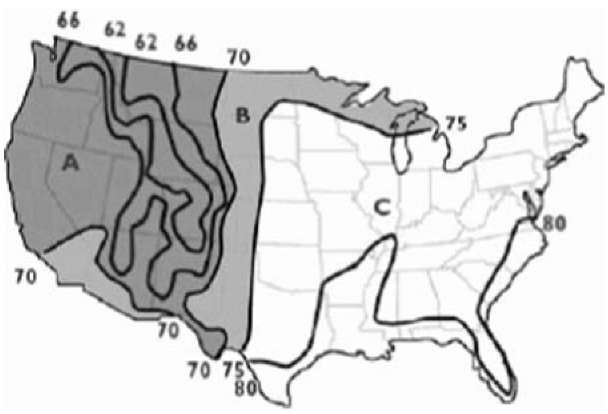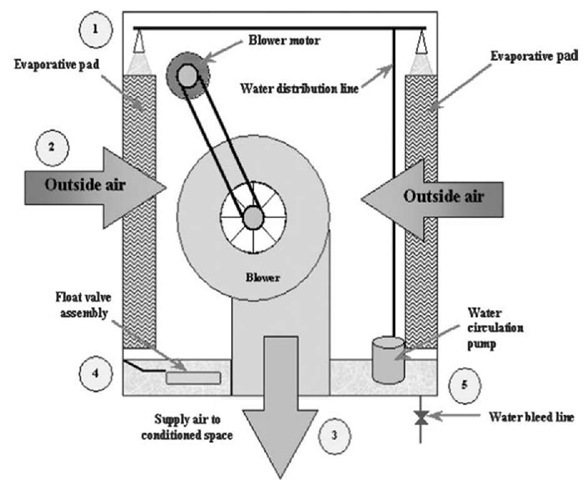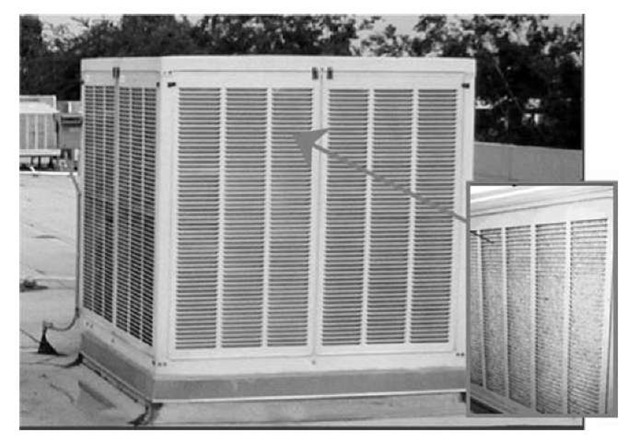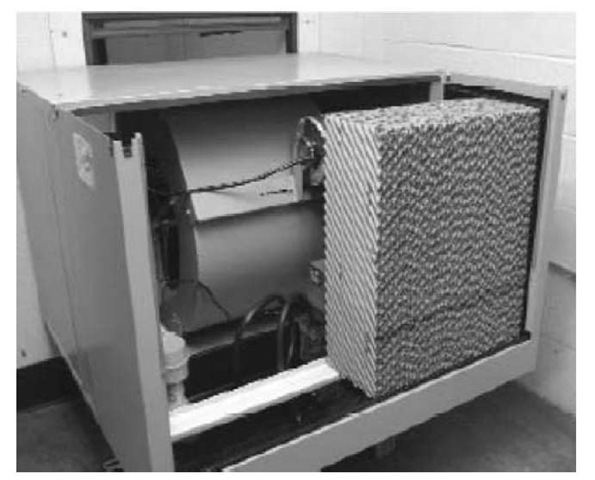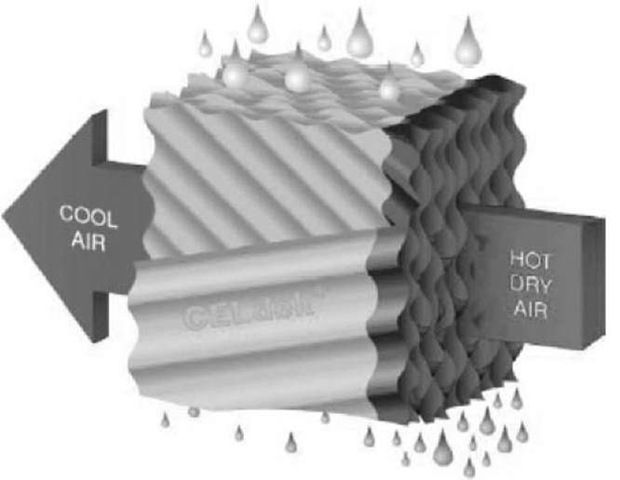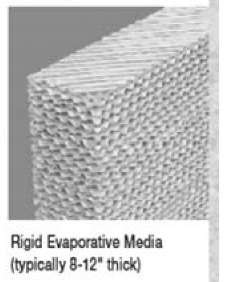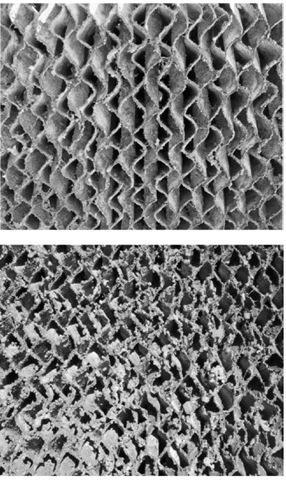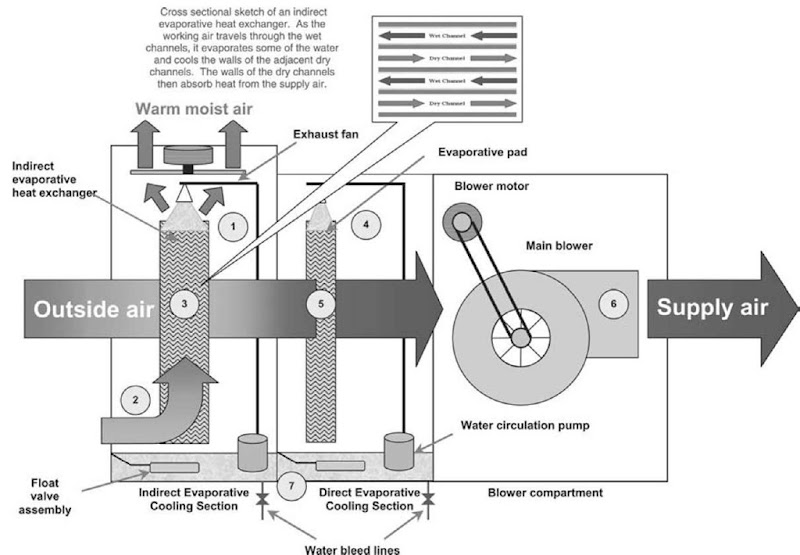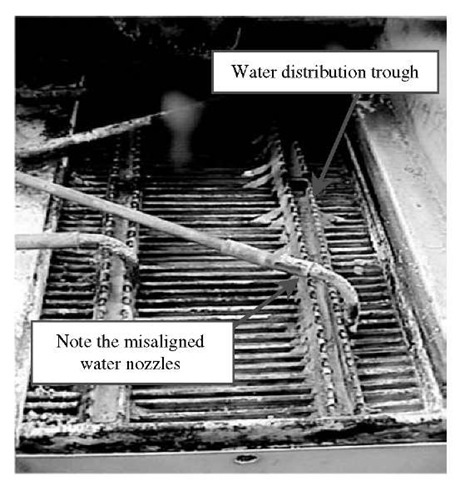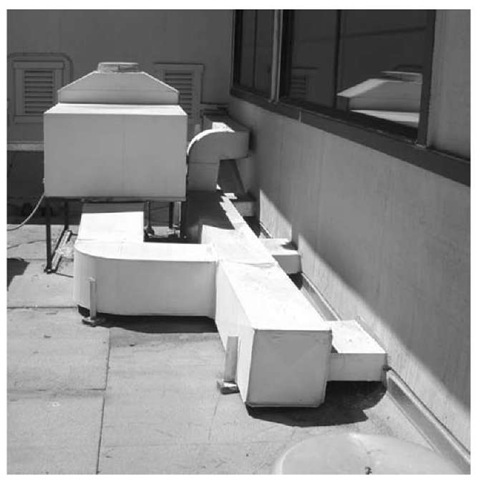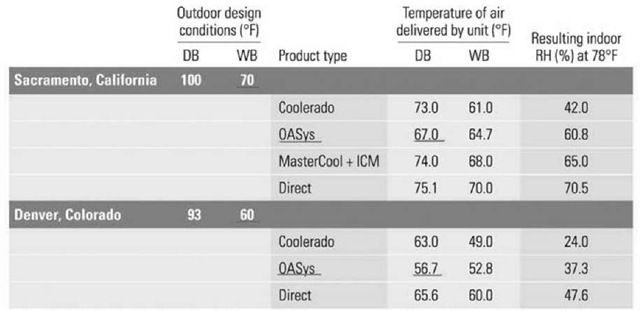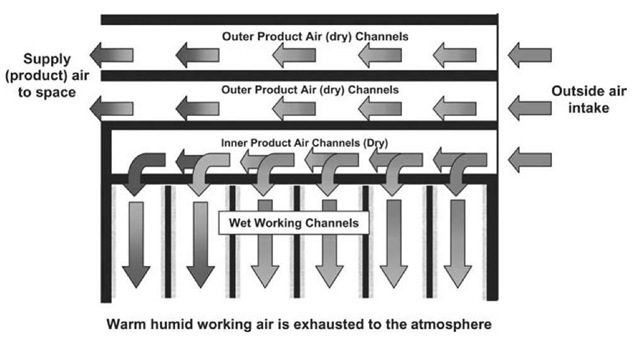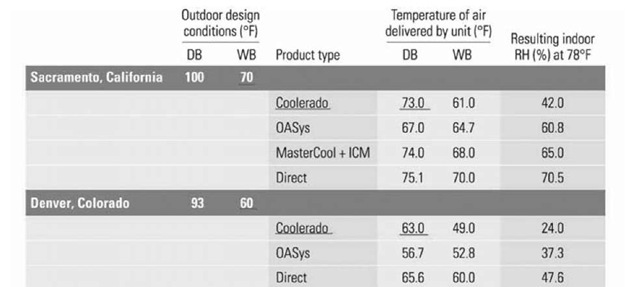Abstract
This report discusses the principles of evaporative cooling and provides an overview of the different types of systems currently on the market. It includes diagrams, system comparisons and a discussion of market barriers for direct evaporative coolers, indirect-direct evaporative coolers (IDECs) and the Coolerado Cooler.
INTRODUCTION
It is another sizzling summer day in America. Radio and television news weather forecasters wearily predict high temperatures of over 100°F all week long. Electric utilities all across the nation urge people to conserve electricity. Electricity demand and prices soar as air conditioners struggle to keep people comfortable. Although the energy crisis of 2001 may be over, the need for high efficiency air conditioning systems remains stronger than ever. This report discusses the principles of evaporative cooling and provides an overview of the different types of systems currently on the market.
PRINCIPLES OF EVAPORATIVE COOLING
When air comes into contact with water, some of the water evaporates. This happens because the temperature and the vapor pressure of the water and the air attempt to equalize. As the water molecules become a gas (evaporate), they “absorb” heat from the surrounding air and lower its temperature. The heat is still present, however, it has just been “captured” in the form of water vapor within the air (humidity). This phenomena is known as adiabatic cooling and is found throughout Nature—lakes, rivers, oceans, and anywhere there is water. Today people use evaporative cooling systems for a wide variety of purposes—comfort cooling, manufacturing processes, and other applications.
Some cool terms
Dry-bulb temperature: Temperature of air independent of its moisture content. It may be measured by using common thermometers.
Wet-bulb temperature: The lowest theoretical temperature achievable by evaporating water in a quantity of air at a given dry bulb temperature and humidity level, using only the heat within the air. It is measured by placing a moist piece of fabric over the thermometer and blowing air across it. The air evaporates the water, lowering the temperature on the thermometer to the wet bulb temperature1.
Absolute humidity: The amount of water vapor present in air.
Relative humidity: The amount of water vapor present in air compared to the maximum amount it could hold.
Direct evaporative cooler: System in which the air comes into direct contact with wetted pads before entering the conditioned space. Commonly called swamp coolers.
Indirect-direct evaporative cooler (IDEC): System that uses a combination of direct evaporative cooling and an indirect evaporative heat exchanger. Commonly called two-stage evaporative coolers.
The effectiveness of evaporative cooling depends greatly upon the humidity or amount of water vapor in the air. Simply put, the drier the air, the more effective evaporative cooling will be. Air conditioning technicians often use a special thermometer known as a sling psychrometer to determine how much water vapor is present in the air. Essentially, this measurement involves placing a wet cloth (wick) on a thermometer and spinning the psychrometer until the water has evaporated and recording the lowest temperature obtained. This measurement is known as the “wet-bulb” temperature. What is important to understand about wet bulb temperature is that it tells us what the theoretical lowest supply air temperature for direct evaporative coolers will be. For example, standard design conditions for sizing residential cooling systems in Sacramento, California are:
• Outside air (a.k.a. “dry bulb”) temperature: 100°F
• Wet bulb temperature: 70°F (relative humidity 23%)
• Desired indoor temperature: 78°F.
Fig. 1 Supply air temperatures delivered by direct evaporative coolers.
Under these conditions, the lowest theoretical supply air temperature that a standard evaporative cooler could provide would be 70°F. Realistically speaking, however, most direct evaporative cooling systems would only be able to achieve 78°F (Fig. 1). To put this into perspective, conventional refrigerant-based air conditioning systems are designed to deliver air at temperatures of about 55°F-65°F. At first glance, it appears that direct evaporative coolers would not work. After all, it is difficult to cool a home using 80°F air. To make matters worse, direct evaporative coolers increase the humidity within the house—making conditions even less comfortable. Fortunately, these shortcomings are somewhat mitigated by what is known as “effective temperature.” Since evaporative coolers run at airflow rates that are 3-5 times higher than conventional air conditioning systems, they create a “cooling breeze” that makes the occupants of a room feel 4-6 degrees cooler than the actual temperature. For this reason, the effective temperature created by an evaporative cooler will feel 4-6 degrees cooler than the temperatures shown in the chart shown in Fig. 1. This chart also shows the dramatic effect that humidity has upon the performance of evaporative cooling systems. For this reason, direct evaporative cooling systems are limited to climates with low relative humidity levels. However, newer types of evaporative cooling systems, such as the OASys and the Coolerado Cooler may help somewhat overcome this limitation (more on this later).
Types of Evaporative Cooling Systems
There are three basic types of evaporative cooling systems: direct evaporative coolers (a.k.a. “swamp coolers”), indirect-direct evaporative coolers (IDECs), and the Coolerado Cooler.
Direct Evaporative Cooling Systems
In direct evaporative cooling systems, a.k.a. swamp coolers, the conditioned air comes into direct contact with the water used to produce the cooling effect. These systems are relatively simple and are widely used to provide comfort cooling for mobile homes, single-family housing, and industrial warehouses. Direct evaporative cooling systems generally cost about half as much to install as traditional vapor-compression systems and consume only about a fourth of the energy.[1] However, as discussed earlier, swamp coolers are limited to climates with dry air and produce high humidity levels within the conditioned space (Fig. 2). This is a considerable market barrier since studies conducted by American Society of Heating, Refrigerating, and Air-Conditioning Engineers (ASHRAE) and others have consistently shown that most people prefer lower humidity levels.
Fig. 2 Map showing climate zones suitable for direct evaporative coolers. Map is based upon wet bulb temperatures at 1% design conditions. Evaporative coolers would work best in the dry climates (areas marked A) may work somewhat in the areas marked B. However, in the eastern parts of the country, other types of air conditioners should be used.
Fig. 3 Direct evaporative cooling system (fiber pad type).
Overview of Operation (Fig. 3)
1. Water is pumped from the basin (bottom of the unit) and distributed across the top of the evaporative cooling pads. These pads are usually made of wood shavings from aspen trees or other absorbent materials. Some of the water saturates the pads while the rest falls back down into the basin.
2. The blower draws outside air across the face of the evaporative cooling pads. When the air comes into contact with the wetted pads, some of the water evaporates and lowers the dry bulb temperature of the air.
3. The blower delivers cool moist air to the conditioned space. Since this air is very humid, it must ultimately be exhausted through open windows or relief dampers.
4. The evaporated water is replaced via a float valve assembly.
5. When water evaporates, minerals and other impurities are left behind. Eventually the water within the basin will become supersaturated with minerals and scale will begin to form on the surfaces of the cooler. To help address this issue, some water must be drained off (via the “bleed line”) and replaced with fresh water. Modern systems accomplish this by periodically purging the basin water via a timer-controlled pump.
Not all Direct Evaporative Coolers are Created Equal
There two distinct types of direct evaporative coolers: fiber pad coolers and rigid sheet pad coolers.
1. Fiber pad coolers: (Fig. 4) the most commonly used evaporative cooling systems use pads that are made from shredded aspen wood fibers (a.k.a. excelsior) packed within a plastic net. Although synthetic fiber pads are available, they seldom perform as well as high-quality aspen pads. Fiber pads usually range from 1 to 2 in. in thickness. They are disposable and should be replaced every 1 or 2 years.[4] 2. Rigid sheet pad coolers: (Fig. 5) this type of cooler, also known as a “single-inlet cooler,” used to be found only in large commercial applications, but is now becoming more common in residential applications as well. It uses rigid-sheet pads made from corrugated material that allows air to move through at higher velocities than is possible with aspen pads. Rigid sheet pads are usually 8 or 12 in. thick and have a corrugation pattern that forces water to flood the pad’s air inlet side where most of the evaporation of water occurs. They can last for many years if water quality is properly maintained (Fig. 6).
Fig. 4 Fiber pad evaporative cooler with aspen pads.
Fig. 5 Direct evaporative cooler with rigid sheet pads.
Fig. 6 Modern evaporative cooling media have to be efficient, which means that they must allow for as much cooling as temperature conditions allow while minimizing pressure drop, thereby saving fan power. Well-designed media filter the airstream but are also self cleaning in that the water dripping across the media to the sump below performs a cleaning function. Finally, the media should be durable and easy to replace at the end of their functional lifetime. Master Cool from Munters uses alternating corrugated layers to achieve these ends.
Rigid sheet pad coolers are substantially more expensive than fiber pad coolers, but are much more energy efficient. According to a fact sheet published by Pacific Gas and Electric Company (PG&E), rigid sheet pad coolers can deliver air that is 5-10 degrees cooler than conventional aspen pad media coolers.[5] Both PG&E and Southern California Edison offered rebates to residential customers for qualifying “Energy Efficient Ducted Evaporative Coolers” (EEDEC) in 2005 (Fig. 7).
Finally, at least one prominent manufacturer, AdobeAir Inc., offers evaporative media (pads) that have been treated to resist microbial growth. This helps prevent the growth of microbes that can cause stains, odors, and product degradation.
Energy Efficient Ducted Evaporative Coolers (EEDEC)
EEDEC units are more efficient than conventional evaporative coolers because of the following advanced features:
• Evaporative media which comes from manufacturers, and is certified with an 85% or higher evaporation efficiency delivers air that e 5 to 10 degrees cooler than the air delivered by a conventional aspen pad media evaporative cooler.
• Multi-function controls allow the EEDEC to also function as a whole house fan.
• Pressure refef dampers, if present, help in two ways: 1) they exhaust air to the outside typically through the attic keeping the attic cool which may reduce heat gain in the house, and 2) allow the system to operate when the house is not occupied.
• Special thermostatic controls remotely mounted to the wall and paired with pressure relief dampers allow for operation of the unit based on cooling requirements of the home.
• A water quality management pump eliminates old water from the system periodically and uses less water overall than continuous bleed systems.
• The EEDEC provides fresh air as it cools, using 100% outside air instead of re-circulating the existing indoor air as with conventional central air conditioning.
Fig. 7 Excerpt from a technical fact sheet produced by Pacific Gas & Electric Company (PG&E).
Choosing the Right-sized Evaporative Cooler
Because direct evaporative coolers do not actually remove heat, they are rated by airflow instead of cooling capacity. According to PG&E, the following formulas may be used to determine the proper size cooler needed for residential applications1-5-1:
Hot dry climate: floor area (in square feet) X4 CFM per square foot (based upon 30 air changes per hour and a ceiling height of 8 ft)
Average climate: floor area (in square feet)X 3 CFM per square foot (based upon 22.5 air changes per hour and a ceiling height of 8 ft)
Example: the size of an evaporative cooler needed for a 1500 square foot house in a hot dry climate would be: 1500 ft2 X 4 CFM/ft2 = 6000 cfm
Advantages of Direct Evaporative Cooling Systems
• Simple, proven technology: thousands of units have been sold and installed.
• Low first cost: generally cost less than half of conventional air conditioning systems.
• Energy efficient: 75% energy savings compared to conventional air conditioners.
• Easy to operate and service: units and replacement parts are widely available from multiple vendors, including many home improvement stores.
• Provides excellent ventilation: uses 100% outside air and may be used in a similar manner as a whole house fan (when operated in the fan only mode).
Disadvantages
• Manufacturers must overcome poor public perception caused by older, inferior equipment.
• Does not work well on humid days or in humid climates.
• Requires venting through open windows or relief dampers.
• Produces high humidity within conditioned space (most people prefer low humidity levels).
• Water quality has a major impact upon system performance and maintenance requirements. Hard water deposits (scale) may clog the media and reduce the airflow across the evaporative cooling pads (Fig. 8). Fortunately, new water quality management control strategies such as periodically purging the basin water have significantly reduced problems with scale.
Fig. 8 Water quality has a major impact upon system performance and maintenance requirements. Note the hard-water deposits (scale) on the pads in the lower photo.
INDIRECT-DIRECT EVAPORATIVE COOLING SYSTEMS
As the name implies, IDEC or two-stage systems incorporate both direct evaporative cooling and an indirect evaporative heat exchanger. Unlike direct systems, the supply air within the heat exchanger does not come into direct contact with the water. Since this process reduces the amount of moisture added to the supply air, IDECs offer increased comfort over swamp coolers. Indirect-direct evaporative coolers cost about the same to install as conventional air conditioning systems, but are nearly four times more energy efficient.
Fig. 9 Indirect-direct evaporative cooler (IDEC) system.
Overview of Operation (Fig. 9)
1. Water is pumped from the basin and distributed across the top of the indirect evaporative heat exchanger. The water clings to the surfaces within the wet channels of the heat exchanger as it travels back down into the basin.
2. The exhaust fan draws working air up through the wet channels. As the working air comes into contact with the water, some of the water evaporates and lowers the surface temperature of the heat exchanger. The warm moist working air is then exhausted through the top of the unit. The evaporated water is replaced via a float valve assembly.
3. The main blower draws outside air (supply air) across the face of the indirect evaporative heat exchanger. When the supply air comes into contact with the cool surface of the heat exchanger, some of its heat is transferred indirectly into the water via the heat exchanger. In other words, the supply air does not come into direct contact with the water. After the supply air passes through the indirect heat exchanger, it continues on to the direct evaporative cooling section.
4. Water is pumped from the basin and distributed across the top of the evaporative cooling pads.
Some of the water saturates the pads while the rest falls back down into the basin of the unit.
5. The main blower draws the supply air across the face of the evaporative cooling pads. When the supply air comes into contact with the wetted pads, some of the water evaporates and lowers its dry bulb temperature.
6. Cool moist air is delivered into the conditioned space. Since this air is relatively humid, it must be exhausted through ducts or open windows.
7. The evaporated water is replaced via a float valve assembly. When the water evaporates, minerals and other impurities are left behind. Eventually the water within the basin will become supersaturated with minerals and scale will begin to form on the surfaces of the cooler. To help address this issue, some water must be drained off (via the bleed line) and replaced with fresh water. Modern systems accomplish this by periodically purging the basin water via a timer-controlled pump.
A Rough Beginning For IDECs
During the late 1990s, some early versions of IDECs were plagued with reliability and performance issues stemming from a lack of understanding regarding proper system installation, misunderstood maintenance requirements and poorly designed systems. Some examples:
1. Reliability: the water troughs of the indirect evaporative heat exchanger of the IDEC shown in
2. Improper installation: simply put, evaporative cooling systems require a lot of air—three to five times more than conventional vapor compression systems. Installers need to ensure that the ductwork is sized and installed correctly to ensure proper airflow is delivered to the conditioned space (Fig. 11).
3. Poor engineering: one particular IDEC system experienced severe reliablity problems due to faulty engineering. Periodically the water float valve would stick and cause the water within the basin to rise. Although there was an overflow drain to prevent the system from overflowing, the blower would draw water droplets into the motor and controls cabinet. Needless to say, water, motors and controls don’t mix. Every time this occurred, it cost the owner about $500 to replace the motor and controls.
Fig. 10 The heat exchanger of this IDEC was rendered useless by misaligned water nozzles. Note also the presence of hard-water scale. This system was not equipped with a bleed line.
Fig. 11 A poorly installed IDEC system. The ductwork is far too restrictive to deliver the airflow needed to meet the cooling requirements of this classroom.
Fig. 10 are designed to distribute water over the evaporative cooling media. Once the troughs are filled, the water is supposed to overflow across the top of the media. Unfortunately, this heat exchanger was rendered useless by misaligned water nozzles. This situation may have been easily avoided through the use of inexpensive hose clamps.
Third Time a Charm?
The Davis Energy Group (DEG) and Speakman CRS have introduced a third generation IDEC known as the OASys that will hopefully overcome many of the problems of the past. The system was designed under a research grant provided by the California Energy Commission’s Public Interest Energy Research (PIER) program. Additional tests were completed in 2005 in a field study sponsored by the Sacramento Municipal Utility District. According to the DEG, the OASys includes the following improvements (Fig. 12):
• Corrosion-proof, single-piece polyethylene cabinet ensures long life.
• Electronically commutated, variable-speed blower fan motor enhances efficiency and comfort during part-load conditions.
• Blower motor is located upstream of the evaporative cooling media—eliminates the chance of water droplets being drawn into the blower fan motor.
• Programmable thermostat that varies the speed of the blower motor in proportion to cooling load requirements.
• Water quality management controls (timed purge cycle).
• High performance evaporative cooling media and indirect heat exchanger enables OASys to cool air below the ambient wet bulb temperatures (Fig. 13).
Fig. 12 Airflow diagram for the OASys.
• Provides excellent ventilation and may be used in a similar manner as a whole house fan (when operated in the fan only mode).
Disadvantages
• Does not work well in humid climates or on humid days.
• Units and replacement parts are not widely available.
• Requires venting through open windows or barometric relief dampers.
• Some previous IDECs have been known to have reliability problems.
• Adds some humidity to the conditioned space (most people prefer low humidity levels).
• Water quality has a major impact upon system performance and maintenance requirements. Hard water deposits (scale) may clog the media and reduce the airflow across the evaporative cooling pads. Fortunately, new water quality management control strategies such as periodically purging the basin water have significantly reduced problems with scale.
Advantages of IDECs
• Energy efficient—75% energy savings compared to conventional air conditioners.
• Offers increased comfort over swamp coolers (less moisture added to supply air).
COOLERADO COOLER
A third type of evaporative cooling system was introduced in 2004—the Coolerado Cooler. This system utilizes a patented indirect evaporative heat exchanger that cools the air multiple times before it enters the conditioned space. In essence this creates a “cascade” effect that enables the Coolerado Cooler to cool the air below the ambient air wet bulb temperature without adding any moisture to the supply air. The patented Coolerado heat and mass exchanger is designed to take advantage of the Maisotsenko Cycle (Fig. 14) and is constructed from cellulose fiber and ethyl vinyl acetate (EVA). The heat exchanger contains both wet and dry channels and separates incoming air into two air streams: Working Air and Product Air. The wet and dry air channels are separated via polyethylene coated sheets.
Notes: D8 ^drybulb temperature; F = Fahrenheit;
RH = relative humidity; W8 = wetbulb temperature. Assumptions for percent wetbulb achieved: Coolerado Cooler = 90; OASys = 11D; MasterfIooi + iCIVU90; Direct = 83.
Notes: D8 ^drybulb temperature; F = Fahrenheit;
RH = relative humidity; W8 = wetbulb temperature. Assumptions for percent wetbulb achieved: Coolerado Cooler = 90; OASys = 11D; MasterfIooi + iCIVU90; Direct = 83.
Fig. 13 Cooling performance for different types of evaporative cooling systems. Note that the dry-bulb temperatures of the air delivered by the OASys are lower than the wet-bulb temperatures of the outside air.
Fig. 14 The Maisotsenko cycle uses the same wet and dry channels as indirect evaporative coolers but with a much different geometry and airflow, creating a new thermodynamic cycle. It works by incrementally cooling and saturating working air and benefiting from that cooling on the next increment. This 2-D diagram of the Maisotsenko cycle shows how air is incrementally cooled by the continuous exhaust of heat followed by additional cooling. This cycle allows any fluid (gas or liquid) to be cooled below the wet-bulb temperature and within a few degrees of the dew-point temperature of the incoming working air. In addition, no moisture is added to the product airstream.
The Working Air is the air used to produce the cooling effect. As it travels through the wet channels of the heat exchanger, it comes into direct contact with wetted cellulose surfaces. When this happens, some of the water evaporates and absorbs heat (indirectly) from the Product Air stream (i.e., the air delivered to the conditioned space), which is traveling through the dry channel of the heat exchanger. This process is repeated several times within the heat exchanger.
Overview of Operation[9] (Fig 15)
1. Outside air is pushed into the Coolerado Cooler heat exchanger with a single fan.
2. Product air channels.
3. Working air channels.
4. Heat from the product air is transferred through the thin plastic and into the Wet Channels below.
5. Working air is blocked from entering the building.
6. The blocked working air is turned and passed through small holes into wet channels below the product air stream.
Fig. 15 Coolerado Cooler’s patented heat-mass exchanger.
7. The working air is now moving through wet channels perpendicular or cross flow above and below the dry channels.
8. The heat that is passed from the dry channel is converted into water vapor.
9. Heat from the product air has been converted to water vapor and is now rejected as exhaust to the outside air.
10. The product air, which has now traveled the length of the heat exchanger, enters the conditioned space cold and dry.
Potential Applications
According to the manufacturer, the Coolerado Cooler may be used to provide residential and commercial comfort cooling or to pre-cool ventilation air for large conventional air conditioning systems in many areas of the United States. The map shown below is based upon the humidity within each climatic zone at the 1% design conditions (Fig. 16).
Advantages
• Energy efficient—75% energy savings compared to conventional air conditioners
• Does not add moisture to the conditioned air
• Able to cool near or below wet bulb temperature of the ambient air (Fig. 17).
• Provides excellent ventilation (Fig. 18).
• System has only two moving parts (supply fan and solenoid valve).
Disadvantages
• Units are not yet widely available.
• Requires venting through open windows or barometric relief dampers.
Fig. 16 Potential applications for the Coolerado Cooler in the continental United States.
Notes: D8 ^drybulb temperature; F = Fahrenheit;
RH = relative humidity; W8 = wetbulb temperature. Assumptions for percent wetbulb achieved: Coolerado Cooler = 90; OASys =110; MasterfIooi + iCIVU90; Direct = 83.
Notes: D8 ^drybulb temperature; F = Fahrenheit;
RH = relative humidity; W8 = wetbulb temperature. Assumptions for percent wetbulb achieved: Coolerado Cooler = 90; OASys =110; MasterfIooi + iCIVU90; Direct = 83.
Fig. 17 Cooling performance for different types of evaporative cooling systems. Note that the dry-bulb temperatures of the air delivered by the coolerado are very close to the wet-bulb temperatures of the outside air.
• Reliability is unknown: fewer than 200 units have been deployed.
• Water quality may impact system performance and maintenance requirements.
SYSTEM COMPARISON
Recall that evaporative cooling systems incorporate adiabatic cooling. In this process, the heat within the air stream is converted into water vapor—it is not actually removed. Because of this, there is currently no established industry metric for comparing the performance of evaporative cooling systems to conventional vapor-compression systems. However, in April of 2005, E Source, a well-respected research firm, published a report on evaporative cooling systems. The chart shown in Fig. 19 provides an excellent summary of the relative performance and costs for all three types of evaporative cooling systems.
CONCLUSION
Evaporative cooling systems offer an energy efficient alternative to vapor-compression air conditioning systems in areas with favorable climatic conditions. Indeed as energy prices continue to climb, consumer demand for ultra-high efficiency air conditioning systems will increase. Innovative systems such as the OASys and the Coolerado Cooler may help overcome market barriers associated with the high humidity conditions provided by traditional swamp coolers. However, these systems will have to prove to be reliable and cost effective in order to compete with well-established refrigerant-based air conditioning systems.
Fig. 18 Coolerado Cooler installation at a school in Sacramento, California.
Notes: cfm = cubic feet per minute; OX = direct expansion; EER = energy-efficiency ratio: CM = Indirect Cooling Module; IDEC – indirect/direct evaporative cooler; kW = kilowatt; NA = not applicable; SEER =seasonal energy-efficiency ratio; WB = wetbulb temperature; *x = trot available.
a. Wetbulb achievable percentage is the percentage of the difference between the drybulb and wetbulb temperature by which the unit can lower the drybulb temperature.
b. EERs listed here for evaporative coolers will vary with airflow and climate and are applicable primarily in the western United States. For the OASys, this number is a sensible EEF and is not directly comparable with the Coolerado Cooler efficiency.
c. Based Dn testing performed by National Renewable Energy Laboratory ICoolerado Cooler) and Davis Energy Group; certified by Lawrence Berkeley National Laboratory {OASys], Pacific Gas and Electric (Mastercool + ICM).
d. Manufacturer’s claim.

